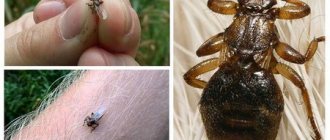Digging
When the ambient temperature begins to drop, the wireworm tries to hide as deep into the soil as possible. Therefore, digging, which helps get rid of most of the parasites, must begin long before the onset of the first frost.
To remove the larvae from the soil, go 12-16 cm deep into the ground. During the digging process, select all insects found from the soil, as well as plant debris, including pieces of roots. At the same time, do not worry that some of the parasites may remain in the ground. They will quickly die because it will be difficult for them to survive the winter without food, which is provided by plants and roots.
Green manure
If you don’t have time to cultivate the area, sow it with green manure. These plants enrich the soil with nutrients and secrete special substances that repel harmful insects.
To get rid of wireworms, plant oilseed radish, mustard, phacelia, rapeseed, alfalfa, buckwheat and any legumes (peas, beans, lupine, etc.). After the green manure grows 15-20 cm, mow it and embed it in the ground while digging. By this time, the wireworm will no longer be on the site, and the plant residues will turn into natural fertilizer.
Preventive measures in the fight against wireworms
The appearance of wireworms, like many other problems, is easier to prevent than to solve.
A few simple precautions will save you from the threat of this pest:
- observe crop rotation;
- remove weeds in a timely manner;
- dig and loosen the soil;
- thin out the potato beds with single plantings of legumes;
- do not thicken the plantings;
- to localize the problem, use legume plantings;
- The wireworm affects not only potatoes, it can spread to carrots, radishes and other vegetables.
Protection from potato wireworm when planting - video
Unlike the Colorado potato beetle, which is easy to spot, the wireworm lives underground.
Do not neglect control loosening of the soil in order to detect the pest.
Remember, proper agricultural technology will not only solve the pest problem, but will also protect your crop for many years to come.
Chemicals
Any chemicals do an excellent job of killing wireworms, but they harm plants, so it is best to use them only in the fall. You can choose Bazudin, Prestige, Force or Provotox. The latter remedy is considered particularly effective, since it is not addictive to insects, is not toxic to humans, and lasts for a long period of time (up to 3-4 months).
But whatever drug you choose, follow the instructions for use, observing the dosage and other recommendations of the manufacturer.
Wood ash
The wireworm does not tolerate low-acid soil, so it can be combated with wood ash, which perfectly deoxidizes the soil. But before using this product, consider the initial acidity levels in your area. If the soil is highly acidic (pH 1-5), add 1 kg of wood ash per 1 square meter. m. For slightly acidic soil (pH 5.5-6.5), this dosage can be halved.
If wireworms appear in your area, do not delay the process of eliminating it for long. If the larvae manage to get deep into the ground, it will be practically useless to fight them.
- Author: iarriba
Rate this article:
- 5
- 4
- 3
- 2
- 1
(0 votes, average: 0 out of 5)
Share with your friends!
How to get rid of wireworms in the garden using folk remedies
All folk recipes are based on plants whose smell cannot be tolerated by wireworms. However, it is also necessary to observe crop rotation. The approach to the fight must be comprehensive.
Lures
It is very effective to combat wireworms in early spring using baits. They are installed at the end of April or the very beginning of May, when the beetles wake up from the cold. A small depression is made in the garden bed and filled with rotted straw or grass. The pit is covered with boards. You can check the trap after 2-3 days. During this time, the beetles will move there; it will be enough to collect and destroy them. The operation is repeated very often to prevent the proliferation of pests.
A trap for wireworms can be made from a tin can, in which several holes are first made. The containers are filled with potato leaves and buried in the ground. You need to check the trap after a few days.
Seeds of cereals, lettuce, and pieces of root vegetables can serve as bait for wireworms. With seeds, everything is simple - after sowing and emergence of seedlings, the area is dug up, destroying the roots on which many wireworm larvae have collected.
Important! Pieces of root vegetables need to be dug up and destroyed along with the collected larvae.
A folk remedy such as sweet bait will help to significantly reduce the number of wireworms on the site. The row spaces are covered with film, and sweet syrup is applied to it. After a few days, all beetles and larvae are destroyed.
Herbal tinctures
Infusions of various herbs are used to protect the garden from wireworms using folk remedies. They are used to cultivate the ground before planting cultivated plants or to water the seedlings; you can spray the tubers before planting.
The following are suitable for preparing folk remedies for wireworms:
- nettle;
- dandelion;
- coltsfoot;
- celandine.
The tops of these plants are crushed and filled with water, infused for 12 hours. However, the infusion of celandine is kept for three days, after which it is filtered. Different amounts of raw materials are taken per bucket of water. Nettle - at the rate of 500 g, dandelion and coltsfoot - 200 g each, but 100 g of celandine is enough. Use fresh products immediately, since they cannot be stored. The amount of raw materials given in the recipes is enough for 20 holes of potatoes.
Important! The treatment is repeated three times with an interval of 10 days.
Eggshell
A folk remedy such as eggshells helps against wireworms. It is collected all winter, dried, crushed with a rolling pin and brought into the ground for digging in the spring.
Throughout the season, crushed shells are poured onto the bed before hilling the potatoes. This procedure significantly reduces the pest population in the garden.
There is another effective way to use eggshells against wireworms - mix the crushed raw material with vegetable oil and place it in each hole. Then plant the crop. The beetle larvae will die from such a treat.
Slaked lime
Slaked lime will help get rid of beetle larvae. It is applied to the soil every 3-4 years. It is enough to scatter lime around the perimeter of the site and dig the bed well. Wireworm larvae are very sensitive to this folk remedy and die quickly.
Potassium permangantsovka
When growing crops in neutral or alkaline soil, the soil is treated with a manganese solution. This folk remedy helps well against wireworms. To prepare, dissolve 5 g of powder in 10 liters of water. The finished product is applied before planting so as not to burn the roots of the plant. One well requires up to 0.5 liters of liquid.
Ash
A good folk remedy for wireworms is wood and coal ash. It is sprinkled on the soil before planting crops, scattered between rows, and applied to the hole during planting.
Onion peel
With its help, you can fight wireworms by preparing decoctions for the garden. This folk remedy can not only drive away wireworms, but also disinfect the soil. A decoction is prepared from dry husks, infused for 24 hours and used to treat holes and tubers before planting.
If there is a lot of onion peel collected, then you can simply spread it into the holes during planting. When watered, it will release substances that repel wireworms.
Tar
A solution of birch tar is suitable for treating tubers against wireworms. It is prepared from 10 liters of water and 1 tbsp. l. facilities. The planting material is sprayed and then laid out in the holes. The prepared solution can be used to treat the soil before planting.
Soda
It is known that wireworms prefer acidic soils, so baking soda is used to reduce soil acidity. You can use it to treat the bed before planting, and soak the planting material in the solution.
Dry soda powder is mixed with sand in equal quantities and evenly distributed over the area of the bed. After this, the area is dug up and prepared for planting. You can repeat the procedure several times, starting in early spring, then by the time of planting there will be practically no wireworms left.
To prepare such a folk remedy as soda solution, you will need 10 liters of hot water and 250 g of powder. The mixture must be mixed well until the soda is completely dissolved. Dip the tubers into the hot solution and allow to dry until a white film forms. It is this that will protect the potatoes from the pest.
This product can be used to water beds throughout the season. It is recommended to apply it to moist soil after watering or rain. So that it gets as deep as possible, where wireworms live.
Green manure plants
Sowing green manure is the easiest and simplest folk way to combat wireworms in the garden. Plants must be selected taking into account the composition of the soil. Since the pest prefers acidic soil, it is better to sow:
- phacelia;
- alfalfa;
- sweet clover;
- mustard.
These herbs deoxidize the soil, and during the growth process they release alkaloids - substances that kill beetle larvae.
Green manure crops should be sown in autumn and early spring as an intercrop. After emergence, when the plants have grown to the desired height, they are trimmed with a flat cutter and embedded in the soil. The digging depth is 10-15 cm. After some time, organic matter will begin to decompose and release substances beneficial to the soil. You can plant potatoes or other crops two weeks after harvesting green manure. After the potatoes have emerged, green manure can be sown between the rows. They will loosen the soil and protect the tubers from larvae.
Infusions of tops will help enhance the effect of green manure. Mustard infusion is considered very effective. The greens are mowed, and part of it is placed in a plastic container, filled with water and left for 7-10 days. This product is used for watering vegetable crops. The active substances of mustard penetrate deep into the soil and destroy the pest.
When sowing green manure, it is also worth considering that not all of them are suitable for wireworms. There are crops that attract pests to the garden.
These include:
- rye;
- wheat;
- oats
The larvae settle in the roots of these plants and feed on them, due to which they grow more actively.











